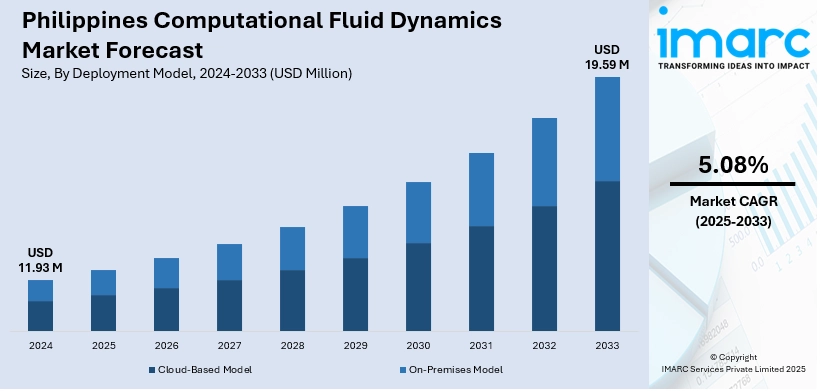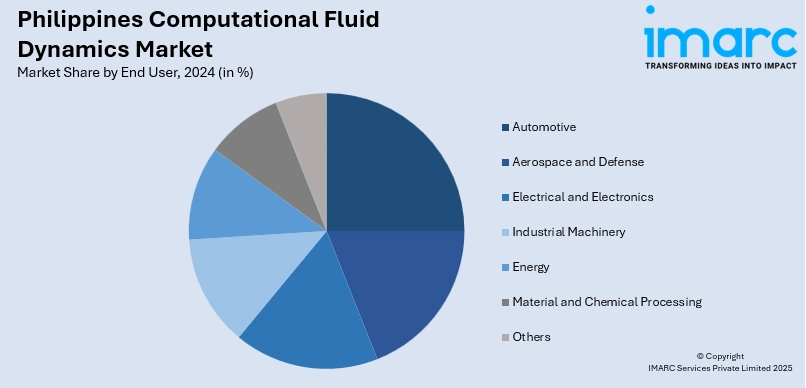
Philippines Computational Fluid Dynamics Market Size, Share, Trends and Forecast by Deployment Model, End User, and Region, 2025-2033
Philippines Computational Fluid Dynamics Market Overview:
The Philippines computational fluid dynamics market size reached USD 11.93 Million in 2024. The market is projected to reach USD 19.59 Million by 2033, exhibiting a growth rate (CAGR) of 5.08% during 2025-2033. Growing demand for energy-efficient systems, government initiatives supporting renewable energy, and rising infrastructure development are some of the factors contributing to the Philippines computational fluid dynamics market share. Increasing use in automotive, aerospace, and healthcare industries, coupled with expanding R&D investments and adoption for predictive analysis, further accelerates market growth in the country.
|
Report Attribute
|
Key Statistics
|
|---|---|
|
Base Year
|
2024
|
|
Forecast Years
|
2025-2033
|
|
Historical Years
|
2019-2024
|
| Market Size in 2024 | USD 11.93 Million |
| Market Forecast in 2033 | USD 19.59 Million |
| Market Growth Rate 2025-2033 | 5.08% |
Philippines Computational Fluid Dynamics Market Trends:
Rising Adoption in Renewable Energy and Power Generation
The Philippines has made significant investments in renewable energy sources, and computational fluid dynamics (CFD) is increasingly being utilized to improve these initiatives. Wind farm developers use CFD models to assess airflow patterns in coastal and mountainous areas, ensuring turbine location maximizes efficiency. Similarly, in the hydropower sector, CFD technologies assist engineers in designing turbines with greater performance and lower cavitation concerns. This trend is consistent with the government's efforts to lessen reliance on imported fossil fuels by promoting sustainable energy programs. CFD also permits thorough modeling of solar power facilities, with airflow and heat distribution models helping to improve cooling systems and overall efficiency. The increased emphasis on sustainability in both public and commercial projects is encouraging organizations to use CFD software to create more accurate, cost-effective designs. Universities and research institutions are also using CFD in renewable energy studies, accelerating its uptake. Renewable energy is predicted to be a long-term development area; hence, demand for CFD solutions in this industry is increasing significantly. These factors are intensifying the Philippines computational fluid dynamics market growth.

To get more information on this market, Request Sample
Expansion in Aerospace and Defense Applications
Beyond traditional industrial uses, the aerospace and defense sectors in the Philippines are emerging as important drivers for CFD adoption. With increasing collaborations between local institutions and international aerospace companies, CFD is being applied in aerodynamics research, aircraft maintenance simulations, and UAV (unmanned aerial vehicle) design. The country’s growing interest in strengthening its defense capabilities is creating opportunities for simulation-based technologies that reduce prototyping costs and accelerate design validation. Local universities are setting up advanced research labs where CFD models are tested on supersonic flow, turbulence, and thermal management problems relevant to aerospace. Meanwhile, defense-related projects are applying CFD in naval vessel design, focusing on hull resistance reduction and fuel efficiency. These specialized applications require advanced CFD tools and expertise, which is encouraging partnerships with global software providers. Although still a niche segment, aerospace and defense applications are positioning CFD as a critical enabler of innovation and self-reliance in the Philippines’ high-technology sectors. This trend highlights a shift toward specialized, high-performance applications of CFD.
Philippines Computational Fluid Dynamics Market Segmentation:
IMARC Group provides an analysis of the key trends in each segment of the market, along with forecasts at the country and regional level for 2025-2033. Our report has categorized the market based on deployment model and end user.
Deployment Model Insights:
- Cloud-Based Model
- On-Premises Model
The report has provided a detailed breakup and analysis of the market based on the deployment model. This includes cloud-based model and on-premises model.
End User Insights:

- Automotive
- Aerospace and Defense
- Electrical and Electronics
- Industrial Machinery
- Energy
- Material and Chemical Processing
- Others
The report has provided a detailed breakup and analysis of the market based on the end user. This includes automotive, aerospace and defense, electrical and electronics, industrial machinery, energy, material and chemical processing, and others.
Regional Insights:
- Luzon
- Visayas
- Mindanao
The report has also provided a comprehensive analysis of all the major regional markets, which include Luzon, Visayas, and Mindanao.
Competitive Landscape:
The market research report has also provided a comprehensive analysis of the competitive landscape. Competitive analysis such as market structure, key player positioning, top winning strategies, competitive dashboard, and company evaluation quadrant has been covered in the report. Also, detailed profiles of all major companies have been provided.
Philippines Computational Fluid Dynamics Market Report Coverage:
| Report Features | Details |
|---|---|
| Base Year of the Analysis | 2024 |
| Historical Period | 2019-2024 |
| Forecast Period | 2025-2033 |
| Units | Million USD |
| Scope of the Report |
Exploration of Historical Trends and Market Outlook, Industry Catalysts and Challenges, Segment-Wise Historical and Future Market Assessment:
|
| Deployment Models Covered | Cloud-Based Model, On-Premises Model |
| End Users Covered | Automotive, Aerospace and Defense, Electrical and Electronics, Industrial Machinery, Energy, Material and Chemical Processing, Others |
| Regions Covered | Luzon, Visayas, Mindanao |
| Customization Scope | 10% Free Customization |
| Post-Sale Analyst Support | 10-12 Weeks |
| Delivery Format | PDF and Excel through Email (We can also provide the editable version of the report in PPT/Word format on special request) |
Key Questions Answered in This Report:
- How has the Philippines computational fluid dynamics market performed so far and how will it perform in the coming years?
- What is the breakup of the Philippines computational fluid dynamics market on the basis of deployment model?
- What is the breakup of the Philippines computational fluid dynamics market on the basis of end user?
- What is the breakup of the Philippines computational fluid dynamics market on the basis of region?
- What are the various stages in the value chain of the Philippines computational fluid dynamics market?
- What are the key driving factors and challenges in the Philippines computational fluid dynamics market?
- What is the structure of the Philippines computational fluid dynamics market and who are the key players?
- What is the degree of competition in the Philippines computational fluid dynamics market?
Key Benefits for Stakeholders:
- IMARC’s industry report offers a comprehensive quantitative analysis of various market segments, historical and current market trends, market forecasts, and dynamics of the Philippines computational fluid dynamics market from 2019-2033.
- The research report provides the latest information on the market drivers, challenges, and opportunities in the Philippines computational fluid dynamics market.
- Porter's Five Forces analysis assists stakeholders in assessing the impact of new entrants, competitive rivalry, supplier power, buyer power, and the threat of substitution. It helps stakeholders to analyze the level of competition within the Philippines computational fluid dynamics industry and its attractiveness.
- Competitive landscape allows stakeholders to understand their competitive environment and provides an insight into the current positions of key players in the market.
Need more help?
- Speak to our experienced analysts for insights on the current market scenarios.
- Include additional segments and countries to customize the report as per your requirement.
- Gain an unparalleled competitive advantage in your domain by understanding how to utilize the report and positively impacting your operations and revenue.
- For further assistance, please connect with our analysts.
 Request Customization
Request Customization
 Speak to an Analyst
Speak to an Analyst
 Request Brochure
Request Brochure
 Inquire Before Buying
Inquire Before Buying




.webp)




.webp)












